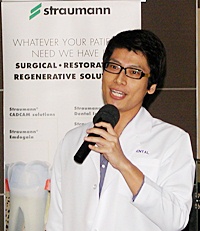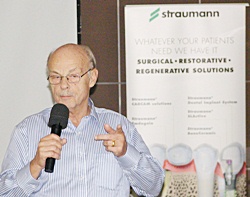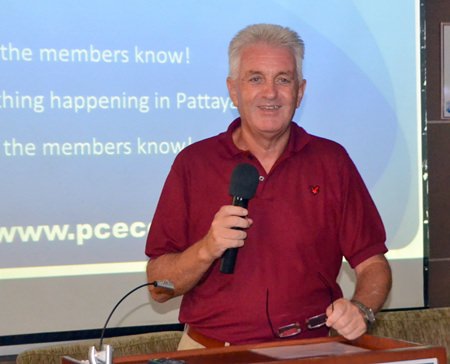“The silent thief of your eyesight.” That’s what Dr. Lachaya Orapiriyakul, M.D., a Specialist in Ophthalmology & Glaucoma from Phyathai Sriracha Hospital, calls glaucoma. Dr. Lachaya was the guest speaker at the August 16 meeting of the Pattaya City Expats Club. She calls Glaucoma a silent thief because its exact cause is unknown, it can damage your vision so gradually that you may not notice any loss of vision until the disease is at an advanced stage, and if left untreated it can lead to blindness.
Basically, glaucoma is a condition in which pressure builds up in the back part of the eye and can eventually lead to damage of the optic nerve. The eyeball contains a watery fluid called aqueous humour which is between the cornea and the crystalline lens. It maintains the pressure needed to inflate the eye and provides nutrition for the central cornea and lens as they do not have their own blood supply. It is constantly produced by the eye, with any excess drained though tubes. Glaucoma develops when the fluid cannot drain properly and pressure builds up.
 Prior to introducing the guest speaker, Gavin Waddell, International Marketing Executive with Phyathai Hospital Sriracha, advises that a nurse is providing free blood pressure checks for PCEC members and guests.
Prior to introducing the guest speaker, Gavin Waddell, International Marketing Executive with Phyathai Hospital Sriracha, advises that a nurse is providing free blood pressure checks for PCEC members and guests.
Dr. Lachaya likened the condition to a clogged sink. The fluid supply is like the water coming out of the faucet and exiting the sink through the drainage pipe. But if the pipe is blocked, the water can’t drain and the sink overflows.
In the case of glaucoma, as the pressure builds up around the optic nerve, it restricts the strength of the signal that the optic nerve can send to the brain. Dr. Lachaya compared it to a coffee cup, where the rim gets thicker and thicker, and the space inside the cup gets smaller and smaller. The result is that it looks like you’re looking through a tunnel, which gradually gets smaller and smaller as the darkness around it grows. Other possible symptoms of glaucoma are blurred vision, pain in the eye, headache, and nausea or vomiting.
 Dr. Lachaya Orapiriyakul from Phyathai Hospital Sriracha explains the effects of Glaucoma to her PCEC audience along with its causes, symptoms, and treatment; with emphasis that it is a silent thief of your vision as the damage can be done before symptoms are noticed.
Dr. Lachaya Orapiriyakul from Phyathai Hospital Sriracha explains the effects of Glaucoma to her PCEC audience along with its causes, symptoms, and treatment; with emphasis that it is a silent thief of your vision as the damage can be done before symptoms are noticed.
Dr. Lachaya described four types of glaucoma: Open-angle, closed-angle, secondary and childhood. Open-angle glaucoma is the most common type. It is painless, tends to develop slowly over time, and often has no symptoms until the disease has progressed significantly. Closed-angle glaucoma is characterized by sudden, acute pain in the eye. Dr. Lachaya said it can be caused by something caught inside the drainage tube. Secondary glaucoma can develop as complications of other medical conditions such as trauma, inflammation, or medications. In childhood glaucoma, children are born with a defect in the angle of the eye that slows the normal drainage of fluid.
 Member Jim Jones provides Dr. Lachaya Orapiriyakul with the PCEC’s Certificate of Appreciation for her informative talk on Glaucoma.
Member Jim Jones provides Dr. Lachaya Orapiriyakul with the PCEC’s Certificate of Appreciation for her informative talk on Glaucoma.
Although the exact cause of glaucoma is unknown, Dr. Lachaya said several risk factors have been identified: (1) High eye pressure (greater than 21 millimeters of mercury or mmHg); (2) Family history of glaucoma; (3) Age greater than 40; (4) Eye trauma history, especially if it caused bleeding; (5) High nearsightedness / farsightedness; and (6) Underlying diseases such as. diabetes, hypertension, and cardiovascular problems. Because people over the age of 40 are at higher risk of glaucoma, she said everyone over that age should have regular glaucoma screening examinations by an ophthalmologist.
 Member Ren Lexander interviews Dr. Lachaya Orapiriyakul about her informative presentation to the PCEC. To see a video of the interview, visit https://www.youtube.com/watch?v=gKPHO_krm6I
Member Ren Lexander interviews Dr. Lachaya Orapiriyakul about her informative presentation to the PCEC. To see a video of the interview, visit https://www.youtube.com/watch?v=gKPHO_krm6I
Although glaucoma cannot be cured, it can be controlled. In the early stages, eye drops can be prescribed to reduce the pressure by reducing water production. Laser treatments or surgical operations can also be used to prevent or slow further damage. Dr. Lachaya said that in surgery, a new hole is created to let the fluid out. Following surgery, you have to have regular follow-up examinations because the body thinks it’s a wound, so it tries to close the hole and pressure can build up again.
 Member Anne Smith makes her inaugural appearance to conduct the Open Forum portion of the PCEC meeting where information is sought and given about Expat living in Pattaya.
Member Anne Smith makes her inaugural appearance to conduct the Open Forum portion of the PCEC meeting where information is sought and given about Expat living in Pattaya.
In answer to a question, Dr. Lachaya described the difference between glaucoma and cataracts: Glaucoma affects the optic nerve, which receives signals from the eye to send to brain; there is no absolute cure. A cataract is a clouding of the lens; the cure is an operation to replace the lens.
After the presentation, MC Roy Albiston brought everyone up to date on upcoming events and called on Anne Smith to conduct the Open Forum, where questions are asked and answered about Expat living in Thailand, especially Pattaya.
For more information on the PCEC’s many activities, visit their website at www.pcecclub.org.




